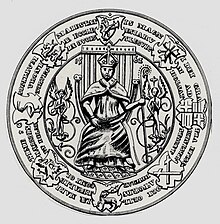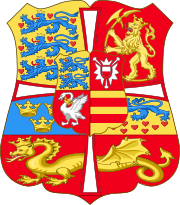| Magnus of Denmark | |
|---|---|
 Seal of Magnus of Denmark Seal of Magnus of Denmark | |
| Bishop of Ösel-Wiek | |
| Reign | 1560–1572 |
| Bishop of Courland | |
| Reign | 1560–1583 |
| King of Livonia (nominal) | |
| Reign | 1570–1578 |
| Born | 5 September 1540 Copenhagen Castle, Denmark |
| Died | 28 March 1583(1583-03-28) (aged 42) Pilten, Courland and Semigallia (now Piltene, Latvia) |
| Burial | Pilten (1583) Roskilde Cathedral (1662) |
| Spouse | Maria Vladimirovna of Staritsa |
| Issue | Marie of Oldenburg Eudoxia of Oldenburg |
| House | House of Oldenburg |
| Father | King Christian III of Denmark |
| Mother | Dorothea of Saxe-Lauenburg |
| Religion | Lutheranism |
| Danish Royalty |
| House of Oldenburg Main Line |
|---|
 |
| Christian III |
Magnus of Denmark or Magnus of Holstein (5 September [O.S. 26 August] 1540 – 28 March [O.S. 18 March] 1583) was a Prince of Denmark, Duke of Holstein, and a member of the House of Oldenburg. As a vassal of Tsar Ivan IV of Russia, he was the titular King of Livonia from 1570 to 1578.
Early life
Duke Magnus was born at the Copenhagen Castle in 1540 as the second son of King Christian III of Denmark and Norway and Dorothea of Saxe-Lauenburg. At the age of 17 he was sent to Germany to be educated at various German courts. Following the death of his father in 1559, he returned to Denmark for the coronation of his older brother, King Frederick II of Denmark.
The same year, the prince-bishop of Ösel-Wiek and Courland Johannes V von Münchhausen in Old Livonia sold his lands to King Frederick II for 30,000 thalers. To avoid hereditary partition of his lands, King Frederick II gave that territory to his younger brother Magnus on condition that he renounced his rights to succession in the duchies of Schleswig and Holstein. In 1560, Magnus landed with an army on Ösel where he was immediately elected bishop by the cathedral chapter.
King of Livonia
See also: Livonian WarDuring the Livonian War, on 10 June 1570, Duke Magnus arrived in Moscow with the approval of his older brother, where he was crowned King of Livonia by Ivan IV of Russia. Magnus took the oath of allegiance to Ivan as his overlord and received from the corresponding charter for the vassal kingdom of Livonia in what Ivan termed his patrimony. The treaty between Magnus and Ivan IV was signed by an oprichnik and by a member of the zemskii administration, the dyak Vasily Shchelkalov. The territories of the new kingdom still had to be conquered, but even so Põltsamaa Castle was proclaimed the future official residence of the king.
The newly crowned king Magnus of Livonia left Moscow with 20,000 Russian soldiers with the intention of conquering Swedish-controlled Reval. Ivan's hope of the support of Frederick II of Denmark, the older brother of Magnus, failed. By the end of March 1571, Magnus gave up the struggle for Reval and abandoned the siege.
In 1577, having lost Ivan's favor and receiving no support from his brother, Magnus called on the Livonian nobility to rally to him in a struggle against foreign occupation. He was attacked by Ivan's forces and taken prisoner. On his release, he renounced his royal title. Magnus gave the rights to the throne to the genus of Stephen Báthory.
Magnus spent the last six years of his life at the castle of Pilten in the Bishopric of Courland, where he died as a pensioner of the Polish crown.
In 1662, Magnus' body was returned to Denmark and was reburied in the Roskilde Cathedral.
Spouse and issue
On 12 April 1574, he married Maria Vladimirovna of Staritsa, daughter of Vladimir of Staritsa, Duke of Staritsa. His issue included:
- Marie of Oldenburg (c. July 1580 – c. 1597)
- Eudoxia of Oldenburg (c. 1581 – c. 1588)
Ancestry
See also
References
- ^ Jaques, Tony (2007). Dictionary of Battles and Sieges. Greenwood Publishing Group. p. 849. ISBN 978-0-313-33536-5.
- Goodrich, S. C. (2008). "Early Russian History". A Pictorial History of England. BiblioBazaar, LLC. p. 150. ISBN 978-0-554-73173-5.
- Eastern Europe: An Introduction to the People, Lands, and Culture, By Richard C. Frucht; ISBN 1-57607-800-0; p.70
- ^ Madariaga 2006, pp. 253–254.
- Viirand, Tiiu (2004). Estonia. Cultural Tourism. Kunst Publishers. pp. 82–84. ISBN 9949-407-18-4.
- War and Peace in the Baltic, 1560–1790 By Stewart Philip Oakley ISBN 0-415-02472-2
- Lockhart, Paul Douglas (1 January 2004). Frederik II and the Protestant Cause: Denmark's Role in the Wars of Religion, 1559-1596. BRILL. ISBN 9004137904 – via Google Books.
- Kønigsfeldt, Johannes Peter Frederik; Danske historiske forening (1856). Genealogisk-historiske tabeller over de nordiske rigers kongeslægter (in Danish). B. Lunos bogtrykkeri. p. 52.
Bibliography
- Madariaga, Isabel de (25 September 2006). Ivan the Terrible. Yale University Press. ISBN 978-0-300-11973-2.
External links
- Livonian Wars, by Kara Broughton
- Die Münzen von Herzog Magnus (in German)
| Preceded byChristian III of Denmark | Duke of Schleswig, Holstein, Stormarn, Dithmarschen, Lauenburg & Oldenburg 1559 |
Succeeded byFrederick II of Denmark |
| Preceded byJohann V von Münchhausen | Bishop of Ösel-Wiek 1560–1572 |
Succeeded byDenmark-Norway |
| Preceded byJohann IV von Münchhausen | Bishop of Courland 1560–1583 |
Succeeded byDenmark-Norway–Polish–Lithuanian Commonwealth |
| Preceded byCommonwealth of Both Nations | King of Livonia (nominal) 1570–1578 |
Succeeded byPolish–Lithuanian Commonwealth |
- 1540 births
- 1583 deaths
- Danish Lutheran bishops
- People from Courland
- People from Livonia
- Princes of Denmark
- Estonian nobility
- Livonian nobility
- Norwegian princes
- Prince-bishops in Livonia
- Polish people of the Livonian campaign of Stephen Báthory
- History of Tallinn
- People from Põltsamaa
- People of the Livonian War
- Children of Christian III of Denmark
- Burials at Roskilde Cathedral
- Sons of kings
- 16th-century Danish Lutheran clergy
- 16th-century Lutheran bishops